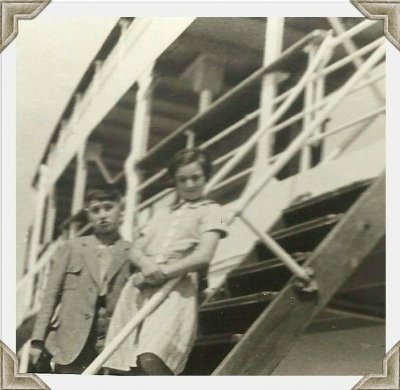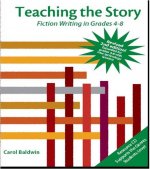Most of us come from families that immigrated to the US and yet, how many of us know our family's story? Who were those ancestors and what did they experience in leaving one home and moving to a strange place?
In this issue, we explore literature and the immigrant experience. |
|
A CONTEMPORARY IMMIGRATION STORY |
by Andrew Bodden
The following contemporary story is true but the names are fictitious.
 When Juan was 3, his mother, Maria, unable to support him because of poor economic conditions, left him with grandparents in Honduras. Determined to find a better life, Maria traveled to the US. She worked, sending money home to provide Juan with the life she never had. When Juan was 3, his mother, Maria, unable to support him because of poor economic conditions, left him with grandparents in Honduras. Determined to find a better life, Maria traveled to the US. She worked, sending money home to provide Juan with the life she never had.
But Juan needed his mother. By the time he was 11, a family member began to abuse him so he decided to find her. Elena, one of Juan’s aunts, started the dangerous journey with him to the US. He suffered from hunger and lack of shelter. But he did not give up.
Passing through Guatemala and Mexico, he experienced terrible things he’d never imagined before. In Mexico a coyote (smuggler) led Juan, Elena, and others walking through the desert. But something terrible happened. Elena fell and injured her back and couldn’t move. The coyote left Juan and Elena in the desert.
Juan didn’t know how to find help, but he walked until he saw a car and waved it down. It was a border patrol car. The patrol airlifted Elena to the hospital and took Juan to an immigration facility. They fingerprinted and booked him but because he was a minor they released him to his mother.
Although Maria is undocumented, Juan is now in school and learning English. However, a judge will decide if he can stay in the US. Meanwhile he gets psychological treatment to cope with the trauma he suffered in his terrifying journey to be with his mother.
In his daily job, with the Mennonite Central Committee, Andrew Bodden witnesses the desperation that brings undocumented immigrants to America's doorstep. |
|
by Carol
The following activities were inspired by a recent trip to Arizona and by my daughter who is exploring her German grandparents' immigration. All can be adapted for group projects or posted on a class wiki.

My mother, Margaret Bonem Federlin, with her brother Frank, in front of the SS Manhatten.They immigrated with their parents from Germany to the U.S. in 1936.
1. Ask students to write a poem, performance, or story from the perspective of any of the characters below. Brainstorm how changing the country of origin and/or the time period will alter the character's experience. Ask students to include reasons the immigrant left home, what he/she hoped to find in the U.S., and conflicts that the immigrant faced.
- An adult immigrant.
- A child of the immigrant. What age?
- A family member left behind. Why did he/she not immigrate?
- A family member in the U.S. waiting for the immigrant.
- Immigrant official or border patrol.
- A descendant of an immigrant.
2. This activity can also be used to create a diorama.
3. Ask your students to interview an immigrant in his family, school, or place of worship. Find out:
- Were there political/religious reasons for immigrating?
- What did they have to do to leave their country?
- How did they travel here?
- Was there a language barrier in coming to the U.S.?
- What was the most difficult cultural change?
- Why did they decide to come to the U.S.?
- Were they welcomed here?
- Create a family history with photos of the immigrant family.
4. Host a classroom debate. Suggested topics:
- Should the US regulate immigration through quotas?
- Should our immigration laws be relaxed?
- Should citizens of specific countries be screened for terrorism?
|
|
by Maggie Barclay

Inside Out and Back Again by Thanhha Lai
10-year-old Hà, her mother, and two brothers board a ship to America after Saigon is invaded during the Vietnam war. Hà has difficulty transitioning to her new home and friends in Alabama and dealing with the loss of her father. I put myself in Hà’s shoes and remembered being made fun of in elementary school and middle school. Every middle school and high school student should read it to see what it feels like to be an outsider. This book is a great book to read about immigration and bullying awareness.
Crossing the Wire by Will Hobbs
Fifteen-year old Victor Flores becomes the breadwinner of his family after his father dies trying to cross the Mexican border. After a hard season, Victor finds out that he won’t be able to sell his family's corn because of American pricing. When Victor finds out that his best friend Rico is going to attempt to cross the border, Victor decides to do the same thing.
I enjoyed reading Victor’s journey but the story became boring during the second half. I was able to feel Victor's desperation, thirst, and hunger, but I didn't enjoy reading about Victor's slowly dying. The story ends suddenly and there should have been some loose ends tied up. The reader doesn't know if Mrs. Flores ever receives the money Victor sends and if the Flores family survived.
The Day of the Pelican by Katherine Patterson
Being forced out of your home is hard enough, but imagine thinking that it was all your fault. Meli Lleshi had a great life in Kosovo: she had a loving family, a comfortable home, and a best friend. While being chased out of their home by Serbian forces, the Lleshi family made it a priority to stay together which kept them alive.
The book shifts from a sad story of a suffering family to a new beginning. When the Lleshis arrive in America, they have to adjust to a new environment and language. I could relate to Meli’s transition of schools and having to make new friends. This story perfectly dictated the struggles of accepting change and learning how to move on from a tough situation.
Maggie is a sophomore at Ardrey Kell High School. She loves reading, watching Doctor Who, playing the clarinet in the marching band, and studying history. |
|
Want to explore a
Writer-in Residence Workshop or Author Visit?
We'd love to hear from you!
We each offer our own author visits or we'll conduct writer residencies together. Contact us and we will design a program that meets your students' needs.

Carol Baldwin
Blog
Email

Joyce Hostetter
Blog
Website
Email |
|
|
|
For best results,
look at
"View as Webpage"
(on pale yellow bar at the top.) |
|
Once again, we have several giveaways.
You can enter even if you've won previously.
Email Us
by
May 21 to enter.
The authors and publishers will appreciate you sharing your win via social media, etc. |
|
Jeannie Moyer Smith won Hiding From The Nazis by David Adler and donated by illustrator Karen Ritz.
Ann Eisenstein won Prisoner B-3087, donated by Scholastic.
Jennifer Marquardt-Leach won Greenhorn written and donated by Anna Olswanger. |
|
Museums:
Real and Virtual |
|
Speaking of
Writing Fiction |

What better way of combining Language Arts with Social Studies than asking your students to write an immigration story? Teaching the Story provides all the tools and hand-outs you'll need to accomplish that task. Here is a free sample hand-out you can download. |
|
My book, Healing Water is
set in Hawaii, a place where immigration changed the society in profound ways.

Healing Water, a story about leprosy, is also about aloha, hope and community!
Healing Water Trailer
|
|
We Welcome Teen Reviewers! |
Do you have a middle school or high school teen who loves to read? We'd love to hear from you with his or her name and contact information. We ask reviewers to read three books and write brief reviews; often soliciting their input on titles. This is a great opportunity for your son, daughter, or student to get experience writing. Please email us if you know someone who would be interested! Thanks. |
|
Thanks to Andrew Bodden, Doris Ettlinger, Maggie Barclay, and Joanne Hunsberger for their generous donations of writing, illustration, reviewing, proofreading.
And thank-you to
Calkins Creek Books for several of the giveaways! |
|
Consider creating a "Talking Story" folder where you file old issues. That way you'll have them handy when you've got time to read, and you'll always be able to view past issues. This works for us! |
|
|
